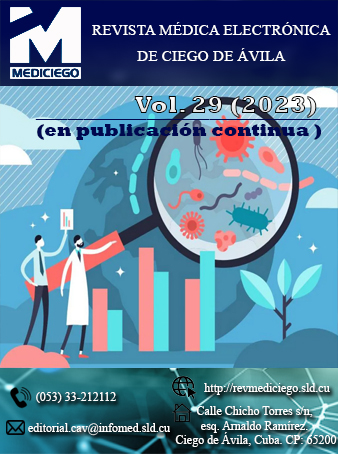Type I Von Recklinghausen disease
Keywords:
neurofibromatosis1, nervous tissue, neurofibromaAbstract
Two photographs are presented of a patient with neurofibromatosis type I, also known as Von Recklinghausen's disease (Fig. 1), treated by collaborators of the Cuban medical mission who worked at the Central Hospital of Nampula, Republic of Mozambique. The patient was referred to the multidisciplinary genetics clinic, where investigations were carried out that demonstrated the presence of neurofibroma-type skin nodules, and in the ocular area the Lysch nodules that are pathognomonic of this disease. Panel A shows the photograph of the thoracic region with the neurofibromas and panel B shows the aforementioned tumors in the knee and the proximal third of the left leg; as well as in the right distal third and ankle.
Neurofibromatosis is a genodermatosis with variable clinical expression. There is extensive knowledge of the pathogenesis of neurofibromatosis type 1, but not of the other clinical forms. Type 1 is an autosomal dominant disease. In this hereditary condition, tumors (neurofibromas) form of nervous tissues in the upper and lower layers of the skin, in the cranial nerves, and in the spinal cord.
Downloads
Published
How to Cite
Issue
Section
License
Copyright (c) 2023 Pedro León Acosta

This work is licensed under a Creative Commons Attribution-NonCommercial 4.0 International License.
Those authors who have publications with this journal accept the following terms of the License CC Attribution-NonCommercial 4.0 International (CC BY-NC 4.0):
You are free to:
- Share — copy and redistribute the material in any medium or format
- Adapt — remix, transform, and build upon the material
The licensor cannot revoke these freedoms as long as you follow the license terms.
Under the following terms:
- Attribution — You must give appropriate credit , provide a link to the license, and indicate if changes were made . You may do so in any reasonable manner, but not in any way that suggests the licensor endorses you or your use.
- NonCommercial — You may not use the material for commercial purposes .
- No additional restrictions — You may not apply legal terms or technological measures that legally restrict others from doing anything the license permits.
The journal is not responsible for the opinions and concepts expressed in the works, which are the exclusive responsibility of the authors. The Editor, with the assistance of the Editorial Committee, reserves the right to suggest or request advisable or necessary modifications. Original scientific works are accepted for publication, as are the results of research of interest that have not been published or sent to another journal for the same purpose.
The mention of trademarks of specific equipment, instruments or materials is for identification purposes, and there is no promotional commitment in relation to them, neither by the authors nor by the editor.

























